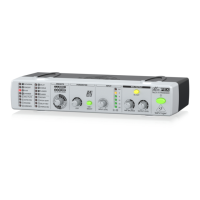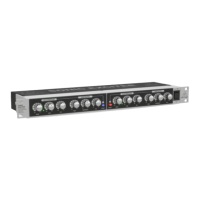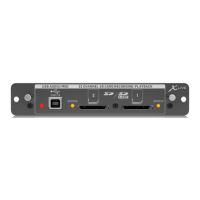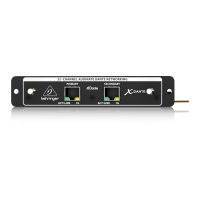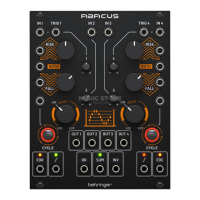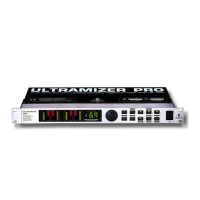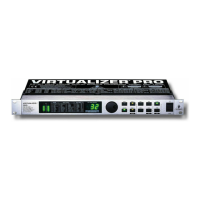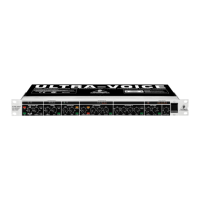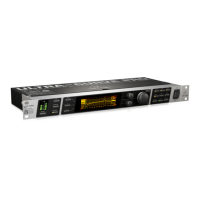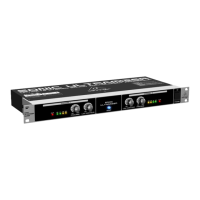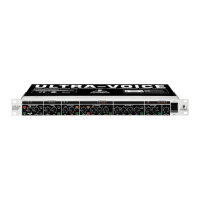24
MODULIZER PRO DSP1224P
Fig. 3.3: Connecting the MODULIZERPRO to a guitar amp (send/return-mono)
The following hints illustrate the MODULIZERPROs versatility if used with a guitar amp. Basically, the
MODULIZERPRO should be inserted between the preamp and the power stage. Almost all guitar amps have
an insert or effect loop to send the preamp signal of the guitar amp to the audio inputs of the MODULIZERPRO.
The MODULIZERPRO processes the preamp signal and sends it back via the guitar amps return bus (power
amp in), from where it is routed to the power stage. When you use a stereo rack system for amplification, you
can wire the MODULIZERPRO in stereo. Connect the preamp to the audio inputs of the MODULIZERPRO,
and the audio outputs (left/right) to one channel each of the power amp (left/right).
+ Since most guitar amps only have a serial insert loop, you should make sure that the
MODULIZERPRO is set to Mix-Intern mode. In this mode you can control the effect intensity
applied to the guitar signal. However, if your amp features a parallel effect loop which allows
for adding the effect-signal portion (similar to an aux path in a mixing console), we recom-
mend that you use the MODULIZERPROs Mix-Extern mode. In this case, the effect intensity
present at the output of the MODULIZERPRO is 100%, and you can use the effect loop to
determine the amount of effect added to the guitar signal.
Instrumentalists can benefit from a variety of advantages offered by the MODULIZERPRO's MIDI implementa-
tion. For example, you can use a MIDI footswitch board to send program change commands via MIDI. Connect
the MIDI OUT jack of your MIDI board to the MIDI IN jack on the MODULIZERPRO. If the MODULIZERPRO
fails to respond to the program change commands sent from the MIDI board, check the MIDI channel settings.
Consult the users manual of your MIDI board to find out on which channels program change commands are
transmitted (usually in Omni mode). Set the MIDI channels appropriately in MIDI mode (see 5.3) and enable
the MODULIZERPRO to receive program change commands.
If your MIDI board features a controller or allows you to connect controller pedals, you can even change
parameter settings via MIDI while playing. For instance, you can freely change the effect intensity from
0-100% while playing (Contr. 27, Value 0-100). Set the controller for Mix-Intern mode (Contr. 30, Value 0) so
that it can be used to increase the effect intensity. In this way, guitar solos can be enhanced with chorus and
delay effects, while the effect intensity is gradually reduced when playing rhythm. You can even control the
function of the IN/OUT switch to bypass the MODULIZERPRO when an unprocessed signal is needed. Basi-
cally, all MIDI devices that are capable of transmitting MIDI controller commands, e.g. keyboards/sequencers,
will allow for using these features.
The MODULIZERPRO may also be inserted between the outputs of a keyboard and the inputs of a mixing
console. If required, adapt the levels with the Operating Level switch.
3.5 Using the MODULIZERPRO in a MIDI system
With its built-in MIDI interface the MODULIZERPRO can be integrated into any MIDI system, where it trans-
mits and receives both program change and controller change information to perform program changes via MIDI
3. APPLICATIONS
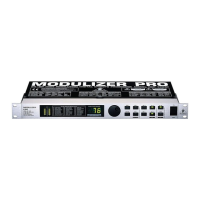
